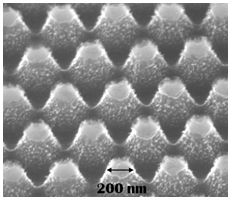|
Development of Si-based
Nanorod Arrays for Antireflective
Application of Solar Cells
Professor Jr-Hau He
Graduate Institute of Photonics and
Optoelectronics, National Taiwan
University
台湾大学光电所 何志浩教授
Two novel techniques are proposed to fabricate Si-based antireflective (AR) nanorod arrays (NRAs). These NRAs are designed with the attempt to enhance the conversion efficiencies of solar cells. The proposed techniques include: i) reactive ion etching (RIE) combined with colloidal lithography; ii) wet etching with HF/AgNO3 solutions. In the 1st technique, self-assembly polystyrene nanospheres are used as the etching mask for the following RIE. With proper etching conditions, NRAs with different geometric features can be achieved. In the 2nd technique, the electrochemical redox reaction between Ag+ and Si, and the subsequent etching effect by HF are used to produce the NRA structures. Compared with the conventional quarter-wavelength AR coating, where the reflectance only reaches the minimum at a certain wavelength, these NRAs exhibit superior AR properties, including broadband working range, omnidirectionality and stable adhesion. The fabrication and characterization techniques demonstrated in our lab are expected to expedite the development of the next-generation solar cells. For more information, please visit our website (http://cc.ee.ntu.edu.tw/~jhhe).
|
 |
|
Fig. 1 Si nanorod arrays with enhanced antireflection performances were achieved by increasing the edge tilting with specific reactive ion etching conditions. |
|